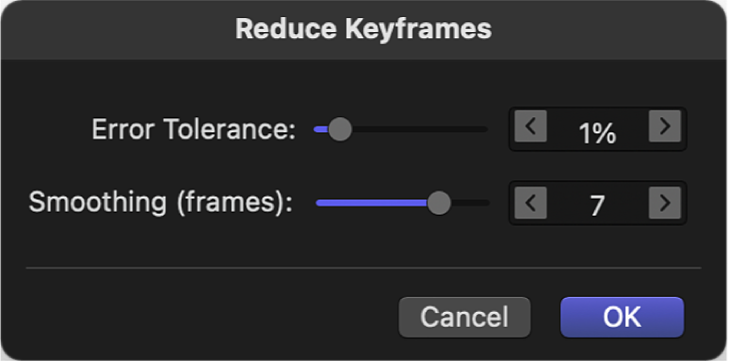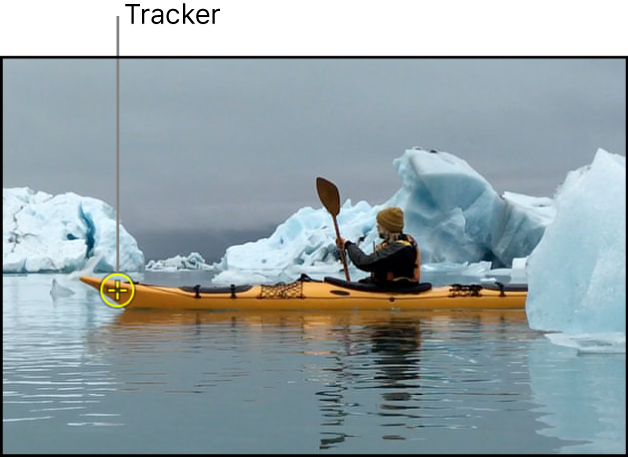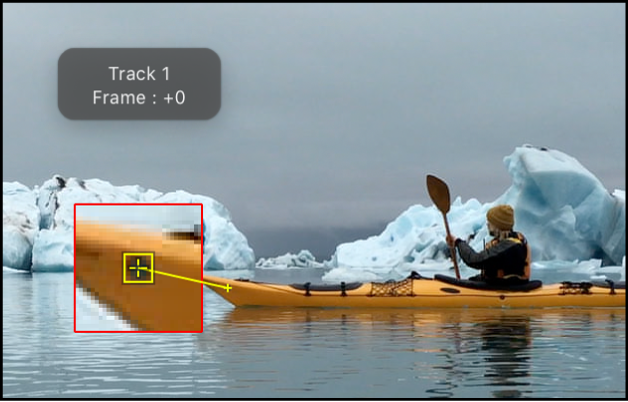Motion User Guide
- Welcome
- What’s new
-
- Intro to basic compositing
-
- Intro to transforming layers
-
- Intro to transforming layers in the canvas
- Transform layer properties in the canvas
- Transform tools
- Change layer position, scale, or rotation
- Move a layer’s anchor point
- Add a drop shadow to a layer
- Distort or shear a layer
- Crop a layer
- Modify shape or mask points
- Transform text glyphs and other object attributes
- Align layers in the canvas
- Transform layers in the HUD
- Transform 2D layers in 3D space
-
- Intro to behaviors
- Behaviors versus keyframes
-
- Intro to behavior types
-
- Intro to Parameter behaviors
- Audio behavior
- Average behavior
- Clamp behavior
- Custom behavior
- Add a Custom behavior
- Exponential behavior
- Link behavior
- Logarithmic behavior
- MIDI behavior
- Add a MIDI behavior
- Negate behavior
- Oscillate behavior
- Create a decaying oscillation
- Overshoot behavior
- Quantize behavior
- Ramp behavior
- Randomize behavior
- Rate behavior
- Reverse behavior
- Stop behavior
- Track behavior
- Wriggle behavior
-
- Intro to Simulation behaviors
- Align to Motion behavior
- Attracted To behavior
- Attractor behavior
- Drag behavior
- Drift Attracted To behavior
- Drift Attractor behavior
- Edge Collision behavior
- Gravity behavior
- Orbit Around behavior
- Random Motion behavior
- Repel behavior
- Repel From behavior
- Rotational Drag behavior
- Spring behavior
- Vortex behavior
- Wind behavior
- Additional behaviors
-
- Intro to using generators
- Add a generator
-
- Intro to image generators
- Caustics generator
- Cellular generator
- Checkerboard generator
- Clouds generator
- Color Solid generator
- Concentric Polka Dots generator
- Concentric Shapes generator
- Gradient generator
- Grid generator
- Japanese Pattern generator
- Lens Flare generator
- Manga Lines generator
- Membrane generator
- Noise generator
- One Color Ray generator
- Op Art 1 generator
- Op Art 2 generator
- Op Art 3 generator
- Overlapping Circles generator
- Radial Bars generator
- Soft Gradient generator
- Spirals generator
- Spiral Drawing generator
- Use Spiral Drawing onscreen controls
- Star generator
- Stripes generator
- Sunburst generator
- Truchet Tiles generator
- Two Color Ray generator
- Save a modified generator
-
- Intro to filters
- Browse and preview filters
- Apply or remove filters
-
- Intro to filter types
-
- Intro to Color filters
- Brightness filter
- Channel Mixer filter
- Color Adjustments filter
- Color Balance filter
- Example: Color-balance two layers
- Color Curves filter
- Use the Color Curves filter
- Color Reduce filter
- Color Wheels filter
- Use the Color Wheels filter
- Colorize filter
- Contrast filter
- Custom LUT filter
- Use the Custom LUT filter
- Gamma filter
- Gradient Colorize filter
- HDR Tools filter
- Hue/Saturation filter
- Hue/Saturation Curves filter
- Use the Hue/Saturation Curves filter
- Levels filter
- Negative filter
- OpenEXR Tone Map filter
- Sepia filter
- Threshold filter
- Tint filter
-
- Intro to Distortion filters
- Black Hole filter
- Bulge filter
- Bump Map filter
- Disc Warp filter
- Droplet filter
- Earthquake filter
- Fisheye filter
- Flop filter
- Fun House filter
- Glass Block filter
- Glass Distortion
- Insect Eye filter
- Mirror filter
- Page Curl filter
- Poke filter
- Polar filter
- Refraction filter
- Ring Lens filter
- Ripple filter
- Scrape filter
- Sliced Scale filter
- Use the Sliced Scale filter
- Sphere filter
- Starburst filter
- Stripes filter
- Target filter
- Tiny Planet filter
- Twirl filter
- Underwater filter
- Wave filter
-
- Intro to Stylize filters
- Add Noise filter
- Bad Film filter
- Bad TV filter
- Circle Screen filter
- Circles filter
- Color Emboss filter
- Comic filter
- Crystallize filter
- Edges filter
- Extrude filter
- Fill filter
- Halftone filter
- Hatched Screen filter
- Highpass filter
- Indent filter
- Line Art filter
- Line Screen filter
- MinMax filter
- Noise Dissolve filter
- Pixellate filter
- Posterize filter
- Relief filter
- Slit Scan filter
- Slit Tunnel filter
- Texture Screen filter
- Vignette filter
- Wavy Screen filter
- About filters and color processing
- Publish filter controls to Final Cut Pro
- Using filters on alpha channels
- Filter performance
- Save custom filters
-
- Intro to 3D objects
- Add a 3D object
- Move and rotate a 3D object
- Reposition a 3D object’s anchor point
- Exchange a 3D object file
- 3D object intersection and layer order
- Using cameras and lights with 3D objects
- Save custom 3D objects
- Guidelines for working with 3D objects
- Working with imported 3D objects
-
- Intro to 360-degree video
- 360-degree projects
- Create 360-degree projects
- Add 360-degree video to a project
- Create a tiny planet effect
- Reorient 360-degree media
- Creating 360-degree templates for Final Cut Pro
- 360-degree-aware filters and generators
- Export and share 360-degree projects
- Guidelines for better 360-degree projects
-
- Intro to settings and shortcuts
-
- Intro to Keyboard shortcuts
- Use function keys
- General keyboard shortcuts
- Audio list keyboard shortcuts
-
- Tools keyboard shortcuts
- Transform tool keyboard shortcuts
- Select/Transform tool keyboard shortcuts
- Crop tool keyboard shortcuts
- Edit Points tool keyboard shortcuts
- Edit shape tools keyboard shortcuts
- Pan and Zoom tools keyboard shortcuts
- Shape tools keyboard shortcuts
- Bezier tool keyboard shortcuts
- B-Spline tool keyboard shortcuts
- Paint Stroke tool keyboard shortcuts
- Text tool keyboard shortcuts
- Shape mask tools keyboard shortcuts
- Bezier Mask tool keyboard shortcuts
- B-Spline Mask tool keyboard shortcuts
- Transport control keyboard shortcuts
- View option keyboard shortcuts
- HUD keyboard shortcuts
- Inspector keyboard shortcuts
- Keyframe Editor keyboard shortcuts
- Layers keyboard shortcuts
- Library keyboard shortcuts
- Media list keyboard shortcuts
- Timeline keyboard shortcuts
- Keyframing keyboard shortcuts
- Shape and Mask keyboard shortcuts
- 3D keyboard shortcuts
- Miscellaneous keyboard shortcuts
- Touch Bar shortcuts
- Move assets to another computer
- Work with GPUs
- Glossary
- Copyright

Advanced tracking strategies in Motion
In Motion, use the following advanced techniques to improve your tracking results.
Apply different tracking analysis methods to a clip
In Object mode tracking, if your chosen tracking analysis method (such as Point Cloud) works well only on portions of a clip, you can instruct the tracker to use a combination of analysis methods on the clip.
In a Motion project with an applied Analyze Motion, Match Move, or Track behavior (and the Mode pop-up menu set to Object), move the playhead to the frame where you want to start the first analysis.
In the canvas, position the object tracker on the subject or reference pattern you want to track (see steps 3–4 in Analyze movement in a clip using Object tracking mode).
In the Behaviors Inspector, click the Analysis Method pop-up menu, then choose the Automatic, Combined, Machine Learning, or Point Cloud option.
In the Behaviors Inspector, click Analyze.
When the tracking analysis begins, a progress window opens and displays the analysis method used for the track.
When the analysis reaches the frame in which you want to change analysis methods, click Stop.
Repeat steps 3–5, choosing different analysis methods.
Smooth a track curve in the Keyframe Editor
You can smooth a track with the Keyframe Thinning function. Before smoothing the curve, you might want to copy the behavior (as a backup) to the Library or duplicate the behavior in the project. See Save custom objects to the Library.
In the following graph, there’s a keyframe at every frame, and the curve is somewhat jagged. The following example shows how you can simplify and smooth this curve.

In the parameter list of the Keyframe Editor in Motion, move the pointer over the parameter you want to smooth; when the down arrow appears on the right, click it and choose Reduce Keyframes.
The Reduce Keyframes dialog appears.

The Reduce Keyframes dialog applies a thinning algorithm to the keyframes for the parameter, reducing the number of keyframes while attempting to maintain a similar curve shape.
Adjust the sliders to smooth the curve:
Error Tolerance: Drag right to reduce the number of keyframes used in the curve.
Smoothing (frames): Drag right to create smoother curves between keyframes.
The Smoothing (frames) control modifies the curve by calculating the average of each track point plus its neighboring track points. In other words, if you set Smoothing (frames) to 5, when the value of frame 12 is computed, frames 10, 11, 12, 13, and 14 are considered. If Smoothing (frames) is set to 3, the algorithm uses frames 11, 12, and 13. The larger the Smoothing value, the more points are considered (and thus more calculations done) for every point in the curve.
As you adjust the sliders in the dialog, the curve is modified in the Keyframe Editor.

Click OK.
Apply an Average parameter behavior to a track curve
You can apply the Average parameter behavior to a track curve in the Keyframe Editor to smooth the transition from one keyframe value to another. Averaged motion moves more fluidly.
In the parameter list of the Keyframe Editor in Motion, control-click the name of the keyframed parameter, then choose Average from the shortcut menu.
The track is averaged, and its curve is simplified in the Keyframe Editor.
See Average behavior.
Convert motion tracks to keyframes
If your motion track includes problem tracking points (such as points where the Confidence value is low), you can “bake” the tracking data recorded or referenced by the Match Move, Stabilize, or Unstabilize behavior into keyframes on the transformed object.
Because the Analyze Motion behavior does not transform the image, analyzed tracks cannot be converted into keyframes. However, a Match Move or Stabilize behavior that references data from an Analyze Motion behavior can be converted into keyframes.
In the Layers list in Motion, select the Match Move, Stabilize, or Unstabilize behavior to convert.
Choose Object > Convert to Keyframes (or press Command-K).
A dialog appears confirming the conversion.
Click Convert.
The tracking keyframes are applied to the tracked object, and the tracking behavior is deleted. You can now modify the animation curves in the Keyframe Editor.
See Convert behaviors to keyframes and Modify keyframes in the Keyframe Editor.
Define look-ahead frames
In Point mode tracking in the Analyze Motion behavior, you can direct a tracker where to look in a later frame for its reference pattern. This tool is ideal for the following types of clips:
Clips that contain fast-moving features
Clips with subjects moving in a relatively straight vector (with or without obstructions)
Clips with swish pans (you may need to reset the “look-ahead” tracker at each panning change)
Important: If your track fails and you reposition your point tracker, you must also reset the look-ahead tracker in the canvas to provide a new motion vector from the new reference point.
In Motion, apply an Analyze Motion behavior to a clip.
In the canvas, position the point tracker on a reference pattern.
In the following image, the point tracker is positioned on a reference pattern on the front of the kayak.

In the Behaviors Inspector, adjust the Look Ahead Frames slider to specify how many frames you want the tracker to look ahead.
Note: The maximum default for the Look Ahead Frames slider is 10 frames. However, you can enter a larger frame amount using the adjacent value slider.
Press and hold the Command key, then drag the point tracker in the canvas in the direction the reference pattern is moving in the clip.
As you Command-drag the track point, a magnified inset displays the frame specified in the Look Ahead Frames parameter.

When the look-ahead tracker is positioned on the reference pattern, release the mouse button.
When you click the Analyze button, the new reference point is used as the tracking pattern.
Important: If your track fails and you reposition your tracker, you must also reset the look-ahead tracker in the canvas to provide a new motion vector from the new reference point.
Manually coax a motion track using keyframes
You can manually insert track position keyframes to help guide the tracker toward a reference pattern for challenging tracks. For example, if you have footage with significant motion blur or objects that partially obscure the tracking pattern, you can manually create tracker position keyframes to help guide the tracker.
In Motion, apply a Motion Tracking behavior to the clip, then press A to enable keyframe recording.
In the canvas, drag the tracker to the reference point you want to track.
A track position keyframe is created in the behavior (visible in the Keyframe Editor).
Navigate to the next frame where you want to create a keyframe.
You can press Shift-Right Arrow to jump forward ten frames or press Shift-Left Arrow to jump backward ten frames.
In the canvas, position the tracker at the reference point you want to track.
Repeat steps 3–4 until you’ve completed the track.
If you’re using Object mode tracking, skip to step 7.
If you’re using Point mode tracking, do the following:
In the Behaviors Inspector, move the pointer over the row of the track you manually adjusted, then click Show.
Click the Fail Behavior pop-up menu, then choose Use Existing Keyframes.
Press A again to turn off keyframe recording.
Go to the first frame of the clip, then click Analyze in the Behaviors Inspector.
The object tracker analyzes the frames from the first frame of the clip to the next manual keyframe. The point tracker analyzes all frames, retaining the manual keyframes.
Manually coax a motion track without using keyframes
In Motion, apply a Motion Tracking behavior to the clip.
In the canvas, drag the tracker to the reference point you want to track.
Choose Object > Add Position Keyframe.
This command is available for the Analyze Motion, Match Move, Stabilize (when you use manual trackers), Track Points, and Track behaviors.
Note: Keyframes cannot be created for automatically stabilized footage. Use the Track Region option for adjusting automatic stabilization, or convert the stabilized footage to keyframes. For more information on the Track Region parameter, see Stabilize a shaky clip. For more information on converting tracking data to keyframes, see Convert motion tracks to keyframes above.
Navigate to the next frame where you want to create a keyframe.
Repeat steps 2–4 until you’ve completed the track.
If you’re using Object mode tracking, skip to step 7.
If you’re using Point mode tracking, do the following:
In the Behaviors Inspector, move the pointer over the row of the track you manually adjusted, then click Show.
Click the Fail Behavior pop-up menu, then choose Use Existing Keyframes.
Go to the first frame of the clip, then click Analyze in the Behaviors Inspector.
The object tracker analyzes the frames from the first frame of the clip to the next manual keyframe. The point tracker analyzes all frames, retaining the manual keyframes.
Download this guide: PDF